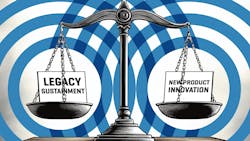What you’ll learn:
- The four most common misconceptions about legacy design and product sustainment, as well as their negative impacts on sustainment plans.
- A better understanding of what legacy sustainment actually looks like compared to traditional obsolescence management tactics.
- The importance of recognizing these misconceptions for what they are and learning from them to better plan for product obsolescence and legacy sustainment.
The old ways of dealing with electronics obsolescence, while initially laying the groundwork for effective sustainment strategies, have spawned several misconceptions about how legacy sustainment works. Many of these misconceptions revolve around the traditional ways of managing the demand for obsolete electronics, solutions that were oftentimes partial but haven’t fully tackled the problem.
What follows are four of the most common misconceptions about electronics obsolescence management, legacy sustainment, and obsolescence risk management.
Myth 1: We just need to find the components.
Electronics obsolescence typically starts with the discontinuation of electronics components, such as microprocessors and memory devices. In response, finding component sources other than the component OEM often seems like an obvious solution (Fig. 1).
Although searching for obsolete components through independent brokers, if successful, might enable fulfilment of immediate demand, there’s no guarantee that these components will be available in the future. Indeed, the computer board on which it resides will continue to encounter discontinuation notices related to other parts, which DOES guarantee future broker searches and unplanned component pre-stocking investment.
Moreover, even if you can find reliable, good-condition components, there’s no guarantee that they will last you as long as you need them to, or that you’ll have enough to last you more than a few years.
Finding components might be part of the solution, though over-reliance on this tactic is a shot in the dark and offers no guarantee that you’ll get the circuit boards you need for as long as you need them.
Myth 2: Last time buys are good for business and encourage customers to upgrade.
When a product is about to be discontinued, it’s typical for embedded OEMs to offer a “last time buy” (LTB) to allow customers a final chance to buy as many parts as they will ever need.
>>Check out the other articles in this series on designing for obsolescence
In many cases, customers’ anticipation of future demand means they will buy two to three years in advance of needs, which is a windfall for OEMs. OEMs also count on the urgency that last time buys create for customers to begin their upgrade cycles.
Unfortunately for customers who need MANY more years of support and have no desire to upgrade, a last-time-buy notice is more of a problem than it is a solution, often straining customer relationships.
Myth 3: Agreeing to ANOTHER last time buy is great for customer relationships.
For certain legacy systems, a single last time buy may suffice to sustain customer operations for several years or until a feasible system upgrade can be implemented. Often, customers will come back to the OEM requesting another “last time buy” after their stock has run out (Fig. 2).
In these cases, it’s not uncommon for OEMs to accommodate these requests not only because of customer pressure, but also the business helps them toward their sales objectives.
Unfortunately, the constant provision of LTBs can create an unsustainable situation for the OEM. Each LTB requires significant logistical and operational effort, diverting resources from new product development and innovation. Furthermore, it can damage the OEM's brand image by creating an expectation of continuous LTB availability, which may not always be feasible or practical to fulfill.
On top of that, repeatedly doing “LTBs” can discourage customers from upgrading to newer, potentially better products. By repeatedly offering LTBs, the OEM inadvertently reinforces the customer's reliance on the outdated technology. This can hinder the adoption of newer, more efficient and innovative solutions that could benefit the customer in the long term.
Myth 4: Extending the life of legacy products cannibalizes new product demand.
A common misconception surrounding legacy product sustainment is the belief that it will negatively impact the demand for new products. There's a fear that supporting older systems prevents customers from purchasing newer models (Fig. 3).
However, this assumption is incorrect. Technological advances necessitate continuous introduction of new products, and most customers will inevitably transition to newer solutions. Supporting legacy systems while customers prepare for upgrades or maintain critical older systems will not hinder the demand for new products.
Customers requiring support for legacy systems typically represent a smaller segment of the overall market. Prioritizing their needs fosters strong customer relationships and can even attract new customers. By demonstrating a commitment to supporting legacy products, companies can enhance their brand reputation and attract a wider customer base.
Final Thoughts
Effectively managing electronics obsolescence requires a shift away from traditional, reactive approaches like relying solely on component sourcing or offering repeated last time buys. These methods, while seemingly expedient, often create short-term gains while hindering long-term sustainability.
By dispelling these common misconceptions and embracing proactive, collaborative solutions, OEMs can navigate the challenges of obsolescence, build stronger customer relationships, and ensure the continued success of their products and their businesses in the evolving technological landscape.
>>Check out the other articles in this series on designing for obsolescence
About the Author
Ethan Plotkin
CEO
Ethan Plotkin is the CEO of GDCA Inc. (“Great Designs Continued Always”), who used his experience in supply-chain risk management (SCRM) to lead the company from its early days as a small OEM into becoming a trusted legacy equipment manufacturing partner for defense and related OEMs across the country. GDCA originally partnered with OEMs as a source for EOL or obsolete circuit boards, but found that they were just a surrogate for obsolescence in the supply chain.
Together with his team, Ethan built on his experience in SCRM to create a systematic approach to sustain and manufacture obsolete electronics—a much bigger mission that’s much more achievable. Under his management, GDCA has become an entirely new type of business—a legacy equipment manufacturer (LEM).
Ethan has also worked extensively with the National Defense Industry Association (NDIA) and currently leads the Supply Chain Network Committee, which facilitates collaboration between government, industry, and other NDIA divisions to strengthen National Security through industrial supply chains. His work in obsolescence management has brought a unique perspective to the many different factors that influence supply-chain challenges and how manufacturers can overcome them.





